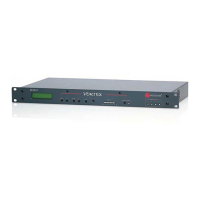rr
AEC reference levels R1, R2
gggg
room gain 1-4
aaaa
AGC gain 1-4
ssss
AEC state 1-4
Each of the i bytes correspond to signal levels on the 9 inputs. The first, eighth, and ninth i bytes indicate
the signal levels on input 1, input D, and input T, respectively. The o bytes correspond to signal levels on the
10 outputs. The first, eighth, ninth, and tenth o bytes indicate the signal levels on output 1, output D, output
T, and output L, respectively. The first and second r bytes indicate the signal levels for AEC references R1
and R2, respectively. The first and last g bytes indicate the room gain for inputs 1 and 4, respectively. The
first and last a bytes indicate the AGC gain on inputs 1 and 4, respectively. The first and last s bytes indicate
the AEC state for inputs 1 and 4, respectively.
The formats of the i, o, r, g, and a bytes are the same as for the binary gain commands (binary values
offset by 132). See
Section 6.3 and Section 6.4 for more information on the binary format.
The range for the i and o bytes is -100 dB to +20 dB, which corresponds to byte values of 32 to 152. For
reference, the LEDs on the front panel signal meter correspond to teh following dB levels (left to right): -20, -
12, -7, -3, 0, 3, 9, 20.
The format of the s bytes are also the same as the binary gain commands. The bytes are integers (offset by
132) that represent the current AEC state. The following table shows how the byte values translate to AEC
states.
Byte Value AEC State Value (Byte Value - 132) AEC State Description
132 0 Idle
133 1 Transmit
134 2 Receive
135 3 Double Talk
Here's an example BLDATA message to clear things up.
B01BLDATAppppèppppppçpppppppppppppèèèèäàåç
The first nine bytes (ppppèpppp) consist of only two values.
p = 0x70 = 112 → 112 - 132 = -20
è = 0x8A = 138 → 138 - 132 = 6
So, the signal at input A is at 6 dB, while the signals at the rest of the inputs are at -20 dB.
The next ten bytes (ppçppppppp) consist of only two values.
p = 0x70 = 112 → 112 - 132 = -20
ç = 0x87 = 135 → 135 - 132 = 3

